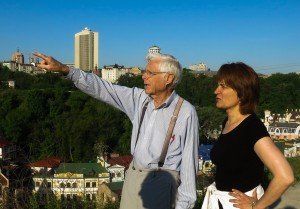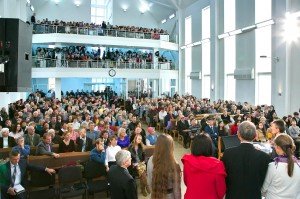 What is Happening in Ukraine?
What is Happening in Ukraine?
[dc]T[/dc]he recent events in Ukraine have captured news headlines around the world. Here is some background information on Ukraine, relevant history regarding the recent events, and information about how this may affect religious liberty and particularly the Seventh-day Adventist Church.
Ukraine is an independent nation of 45.59 million people that is situated between Russia and the Eastern European nations of Hungary, Poland, and Slovakia. Ukraine means “borderland” and prior to its independence it was referred to as “The Ukraine.” Its largest city, Kiev, has a population of 2,847,200 as of July 2013.
Crimea is a northern Ukrainian peninsula with a population of 2,352,384 people as of 2007 located along the Black Sea and is governed by its own constitution in accordance with the laws of Ukraine.
Relevant History
Many are concerned that the current turmoil in Ukraine may be signaling a renewal of the Cold War between the United States and Russia as the people fight over whether they will move toward the European Union favored by the West or the Euroasian Union favored by the Russians. The history of the region is fairly complex, but here is a brief history in a nutshell.
In 1918, a civil war ripped through Ukraine in the wake of the collapse of the Russian Empire. The eastern two-thirds became part of the Ukrainian Soviet Socialist Republic while the western third became part of Poland. In the 1930s, Russian dictator Stalin imposed a man-made famine on Ukraine that killed approximately 7 million Ukrainian peasants, and in 1937 Stalin tried to purge the “intellectuals” through mass executions and deportations.
Soon after, in 1941, Nazi Germany invaded Ukraine killing more than 5 million, and most of Ukraine’s Jewish community were killed. After the war, the USSR annexed the western third of Ukraine. In 1986, the Chernobyl nuclear facility exploded causing massive radiation damage in the region. As the USSR disintegrated, Ukrainians began to express independence and in 1991 following a Moscow coup, 90% voted for independence from Russia.
After World War II, the Soviet Union based its Black Sea Fleet on the Crimean peninsula. When the Soviet Union collapsed, Russian president Boris Yeltsin and Ukrainian president Leonid Kravchuk divided the fleet between Russia and the new Ukrainian Navy.
The next two decades were marked by political turmoil as various leaders were elected and forced to resign under allegations of corruption. In November 2004, Viktor Yanukovych won the presidential election, but observers reported vote rigging. The opposition candidate Vicktor Yushchenko started a campaign of mass street protest and civil disobedience and the Supreme Court overturned the vote.
Another vote for President was taken the following month and pro-Russian Yushchenko won. At the same time, Ukraine’s parliament approved opposition, pro-Western, party leader Yulia Tymoshenko as Prime Minister. In September the next year, Yuschenko dismissed Tymoshenko’s government.
At the same time, Russia attempted to maintain control through its supply of gas to Ukraine, claiming disputes over prices and payments as the reason for stopping and limiting supplies. One of Ukraine’s principle exports is steel, and the global economic crisis of 2008 caused the prices to collapse directly devaluing Ukraine’s currency. As a result, in January 2009 Ukraine could not pay its gas bill and Russia stopped all gas supplies for a week.
The economic instability allowed Yanokovych to win a presidential election in 2010 and rival, Prime Minister Tymoshenko accused him of fraud. She was replaced by a successor chosen by Yonokovych, and was soon charged with corruption and abuse of state funds. She claimed the accusations are false and politically motivated. She was imprisoned for 2.5 years until February 2014, despite a 2013 finding in her favor by the European Court of Human Rights.
During the next two years, Ukraine flirted with the idea of joining NATO and integrating with the European Union and Russia continued to pull the purse strings by controlling imports and exports.
In November 2013 the government abandoned an attempt to join the European Union, leading to mass demonstration in Kiev, claiming that President Yanokovych was bowing to Russian pressure. In December, Yanokovych announced that Russia had agreed to cut the price of gas and to lend Ukraine $15 billion.
In January, under threat from protestors, Yanokovych’s government began to impose significant restrictions on freedom of speech, categorizing anti-government protests as “slander” punishable with a 15-year prison term, and calling organizations that received money from outside Ukraine “foreign agents,” including Christian ministries. The new laws signaled a sudden return to dictatorship that threatened to undo 20 years of post-Soviet reforms.
While most churches did not participate in the protests, evangelicals set up tents in Kiev to distribute religious literature and offer prayer. It is not clear how the Yanokovych government viewed their influence.
In February 2014 police shot at protestors, killing at least 77. The European Union responded by imposing sanctions and protestors stormed the government offices as Yanokovych governmental leaders ran away. Tymoshenko was released from prison and her ally Olexander Turchynov, who also happens to be a Baptist minister, (http://www.ibtimes.com/oleksandr-turchynov-baptist-currently-running-ukraine-1558983) was elected as interim president.
On February 23, 2014 the new Ukrainian government made Ukrainian the sole language of government, pushing out Russian as a secondary language. As a result protestors on both sides clashed in Crimea as pro-Russian Creimans pushed for secession from Ukraine.
In Late February 2014, Russian forces amassed along the border under the pretext of protecting Russian citizens in Ukraine and on February 28, Russian forces occupied key posts, buildings, airports, and other assets in Crimea. On March 1 the Russian parliament gave Russian President Vladimir Putin authority to use military force in Ukraine. The threat of a potential Russian annexation of the semi-autonomous Crimea region alarmed the world.
There were also unsubstantiated rumors that the Russian Black Sea Fleet was demanding the surrender of Ukrainian Navel vessels in Crimea, which included those ships that formerly belonged to the Soviet Union. Russia denied the threat.
China promised to support Russia but the United States opposed Russia intervention. The threat of war alarmed the financial markets causing a major slump when the markets reopened on March 3, 2014.
Putin announced that its top gas producer, Gazprom, would remove a discount on gas prices in April. In an effort to ease tensions, U.S. Secretary of State John Kerry travelled to Kiev and announced a package of $1 billion in loan guarantees for Ukraine to decrease the impact of the energy subsidy cuts which might drive Ukraine back toward Russian control.
As of this writing, Putin is backing off Ukraine, possibly because of the global financial strain the invasion could cause, including in Russian markets.
Religion in Ukraine
In recent years, the Ukrainian government has been committed to religious freedom and non-intervention in religious affairs. Ukraine’s constitution guarantees religious freedom and there is no official state religion. The public schools practice church-state separation. However, there has been religious tension toward the Jewish and Muslim communities. In 2011 the city of Sevastopol approved plans for the first mosque in Ukraine. (See report of Berkeley Center at Georgetown University. )
Since Ukraine became independent in 1991, there has been a division in the Orthodox church between those who favor an autonomous Kiev Patriarchate and those who support the Moscow Patriarchate that mirrors the national division between those who favor joining Europe and those who favor Russia.
After the fall of the Soviet Union, American missionaries used the new freedom to bring the gospel to Ukraine and many people were converted to evangelical Protestantism although the numbers remain relatively small. According to the 2006 CIA/World Factbook, 50.4 percent belong to the Kyiv Patriarchate, 26.1 percent belong to the Moscow Patriarchate, 8 percent identify as Ukranian-Greek Catholic, and 7.2 percent are Ukrainian Autocephalous Orthodox. Two percent are either Roman Catholic or protestant.
Seventh-day Adventism in Ukraine
There are approximately 52,000 Seventh-day Adventists in Ukraine worshipping in 900 congregations and 300 groups. In March 2013, the church launched Hope Channel Ukraine as its fourth full-time satellite channel in Europe potentially reaching 60 percent of the country’s population with a studio in Kiev and several other cities.
Adventists have been active in Ukraine since 1847. Although the church was recognized by the Russian Empire in 1906, all Adventist organizations were liquidated by the Soviets in 1931. Vladimir Shelkov (1895-1980) led a group of Adventists who rejected government intervention in the church, called True and Free Seventh-day Adventists spent almost his entire life in prison, in various periods, from 1931 until his death in a camp near Yakutsk where he had been sentenced to 5 years hard labor in 1979. Shelkov’s group was persecuted by the KGB for refusing to send children to school on Saturdays and to join the military. Group members and leaders also refused to register with the government.
After World War II, Adventists, Baptists, and other protestants had endured significant religious persecution and were sent to mental hospitals and prisons, often for refusing to enter military service. Some were denied parental rights. (See Religious Information Service of Ukraine on Adventists)
Today there is an Adventist seminary in Kiev and the church publishes two newspapers and four magazines. The Adventist Medical Association of Ukraine has nearly 700 employees and the church’s Adventist Development and Relief Agency (ADRA Ukraine) helps victims of natural disasters and the Chernobyl disaster.

In May 2013, Dr. Jay Sloop, a 77-year-old Adventist physician from Yakima, Washington who was working to set up a lifestyle medicine center, went missing while on a morning walk in Kiev. The matter remains open. His son, Greg Sloop, has created a blog addressing the developments in the search. As the long search by volunteers and local authorities has not been successful, a celebration of Dr. Sloop’s life is scheduled for April 26, 2014 at the Yakima SDA Church, 507 N 35th Ave, Yakima, WA 98902.
As of February 3, 2014, according to Adventist News Network, church services were continuing in all 25 Adventist Churches in Kiev and more than 150 literature evangelists, medical missionaries, and pastors were in Kiev to meet the needs of residents. No Adventists were arrested as of that date. The church hopes to send a message of peace, rather than escalating conflicts in what could become a civil war.

The turmoil is happening while the Adventist Church is involved in its program “Kiev: City of Hope,” which provides smoking cessation advice, alcoholism support, diabetes management, postnatal health education and eye care. Adventists are also hosting Christian music concerts and distributing books and invitations for further study. The event will culminate in March with a 10-day evangelistic program.
Victor Alekseenko, the president of the Adventist Church in Ukraine, is asking for Adventists to pray for Ukraine and to avoid provoking hostility on the streets or on the Internet. “Rather, encourage people to resolve conflicts peacefully,” Alekseenko said. Adventists, he added, should find ways to express their civil and political positions within the confines of law and respect for individual rights.
Pray for the peace of Ukraine.
###

